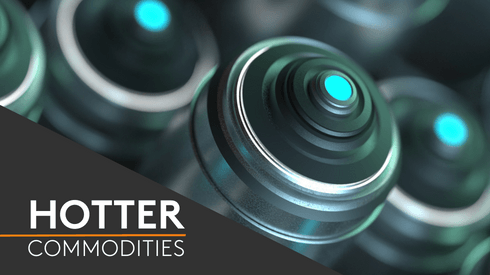US-based ACE Green Recycling is prioritizing investments to recycle lithium iron phosphate (LFP) batteries amid the chemistry’s explosive growth in market share and the uncrowded market landscape, compared with the nickel cobalt manganese (NCM) sector, chief executive officer Nishchay Chadha has told Fastmarkets in an exclusive interview.

“While we can do both NCM and LFP battery recycling, we’ve put our bets on LFP,” Chadha said.
“There are a lot of people competing for the NCM space in a market which is declining, given that its overall share is reducing, whereas LFP is the rising star in the EV [electric vehicle] battery space,” he added.
ACE Green is a producer and operator of modular recycling technologies, which the company says are fully electrified, and produce no Scope 1 emissions, no toxic water and no solid waste.
Black mass produced from shredded and sorted LFP batteries from around the globe made up 22% of global black mass supply in 2024, with the vast majority made in China.
But this will rise sharply to 31% of production by 2034 because of the chemistry’s growing prevalence, according to updated estimates from Fastmarkets’ research team.
On the other hand, while NCM black mass made up 49% in 2024, that is expected to dip to 47% over the next decade, Fastmarkets analysts say.
ACE Green announced in December 2024 that it would go public through a merger with New York-based special purpose acquisition company (SPAC) Athena Technology Acquisition Corp II. Although going public will change little with regard to the company’s business plan, it will increase transparency in the firm’s operations, Chadha said.
In further news, ACE announced earlier this year that it would expand its Indian battery recycling operations with an LFP recycling plant in the western port city of Mundra. It then teamed up with African EV battery maker Spiro to recycle materials collected on that continent.
In the week ended Friday February 21, the firm also announced that it had signed agreements to license its lithium-ion and lead acid battery recycling equipment and technology to Armenian non-ferrous scrap recycling company Mel Metal. Both lithium-ion shredding operations and a lead-acid plant are expected to start operations in the third quarter of 2025.
Does LFP battery recycling capacity matter?
ACE Green’s profile as a smaller-capacity modular recycler gives it an advantage in the nascent LFP recycling space, according to Chadha, because supply of scrap batteries with this chemistry does not yet exist at scale outside of China.
The company intends to set up LFP and lead-acid battery recycling capacity in the US state of Texas over the coming years, and its senior representatives are also “working on some opportunities to build LFP battery recycling capacity within Europe,” Chadha said.
“I would agree that there’s not enough black mass of batteries in Europe available for LFP [recycling today],” he said. “But I think, by the time things get set up in Europe, [which] takes one to two years, we can match the capacity in whatever scale is available in the market.”
Weaker prices for battery metals, and challenges in battery scrap supply in Europe arising from the headwinds to both EV battery production and EV adoption, have led to some major companies delaying their plans on the continent (Umicore, BASF) or cancelling them altogether (Eramet).
But Chadha is confident that this environment is a major advantage for ACE Green.
“We see this as an opportunity because these are all very large [market participants], very substantial players. [The aforementioned firms] like to operate very large projects, which demand a huge amount of capital. That’s just the way these large corporates are structured,” Chadha said.
“And the lithium recycling market [in Europe] cannot accommodate that scale today. That’s why [very large scale] investments don’t have a good return on capital or any return on capital, because there’s hardly any scale available in the market today,” he said.
“That’s where the modularity aspect and low capex operations come into play,” Chadha continued. “And that’s where we think we have a very substantial edge. That’s why we are pushing very hard right now. We see this as an opportunity to get into some key markets [in] the next two years.”
Larger market participants may come back to the market once there is scale, but “by that time, at least, we would have built our own networks, created our own niche and we are always open to partner with these large players,” he added.
Challenges of scale
Chadha pointed to the current situation in South Korea as an example of the challenges relating to recycling at scale.
Korea has the world’s second-largest capacity to consume black mass and produce metals salts and is therefore a major importer of black mass from around the globe.
But profit margins have been badly hurt in the past year amid low metals prices and relatively expensive black mass, due to supply-demand dynamics which have meant that Korean consumers have been forced to raise their buying payables in recent weeks.
Fastmarkets’ assessments of the black mass, NCM/NCA, payable indicator, nickel, cif Southeast Asia, % payable LME Nickel cash official price, and of the black mass, NCM/NCA, payable indicator, cobalt, cif Southeast Asia, % payable Fastmarkets’ standard-grade cobalt price (low-end), were both 73-77% on February 19. That was a record high over the time that Fastmarkets has been pricing the market, starting in September 2023, and was up from 71-75% a week before.
The assessment of the black mass, NCM/NCA, payable indicator, lithium, cif Southeast Asia, % payable Fastmarkets’ lithium carbonate 99.5% Li2CO3 min, battery grade, spot prices cif China, Japan & Korea, was 2.5-4.5% on Wednesday, also unchanged week on week.
“It’s all NCM processing in Korea, and they’ve already been struggling to get supply of black mass,” Chadha said.
“Some of these Korean companies have also set up pre-processing [capacity] in Europe,” he said. “They are also said to have set up trading channels in the US, India and a few other markets such as Malaysia, so that they can get as much black mass as possible.”
A key issue in the NCM recycling sector identified by Chadha was that “conventional solvent extraction only operates at a large scale,” meaning that Korean consumers must rely on large volumes of feedstock from several different origins to keep their facilities operational.
Furthermore, gate fees – the amount a recycler is paid to take scrap – for NCM batteries have dropped in Europe and costs to purchase some forms of scrap in the US market are heard to be very high, hurting pre-processing margins and leading to higher payables, trade sources have told Fastmarkets.
“The lack of scale availability doesn’t help,” Chadha said, “and the fact that there are so many [Korean consumers] who have set up shop, it’s not helping matters. That’s one of the key reasons why, although we have tech for both LFP and NCM, we are focusing on LFP.”
Several Korean black mass consumers have paused or cancelled their plans to expand their hydrometallurgical post-treatment capacity in the coming years amid the highly challenging market environment, a Korean consumer source told Fastmarkets last week.
Greater market regionalization for battery recylcing
Investment into post-treatment technology and capacity rather than pre-processing is preferred by ACE Green, Chadha said.
“We are very focused on creating technologies which are highly differentiated, and in pre-processing there’s hardly any differentiation. You know, a battery crusher is a battery crusher,” he said. “Recycling happens after you’ve created black mass, not before.”
While currently most black mass produced in both North America and Europe leaves in containers to destinations such as South Korea, due to a lack of post-processing capacity, the balance is expected to change over the coming years when local capacities grow.
For Chadha, this structural market shift cannot come soon enough.
“From a fundamental perspective, I completely disagree with the idea of bringing batteries and black mass halfway around the world,” he said, “because [we] are trying to turn these materials into critical materials.”
Although ACE Green has a permit in place to import LFP battery scrap to its factory in Mundra, this is no long-term solution, he said.
“In the short term,” he said, “if there are opportunities [to import scrap] from various markets, yes, we will. But in the longer term, I think the game is to set up modular, localized solutions.”
Keep up to date with global market insights and predictions for the battery recycling and black mass market. Talk to us today.






